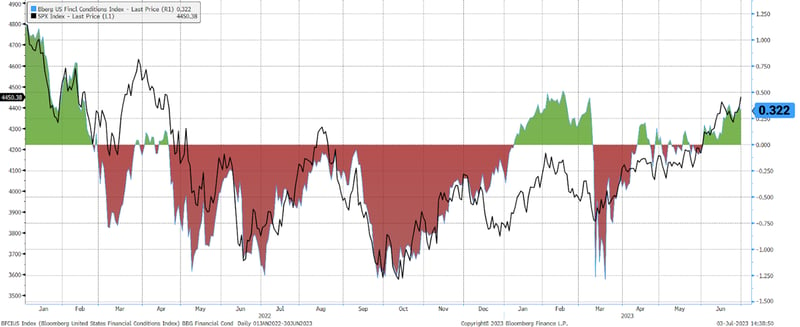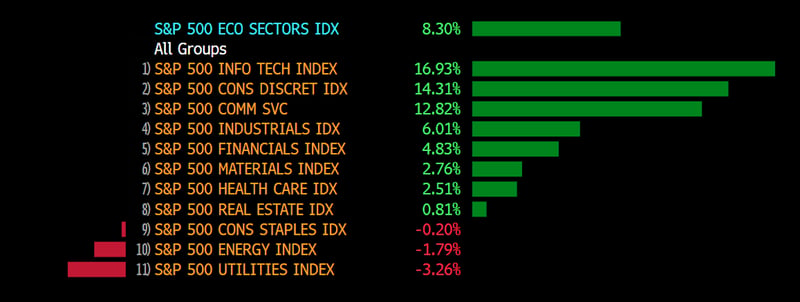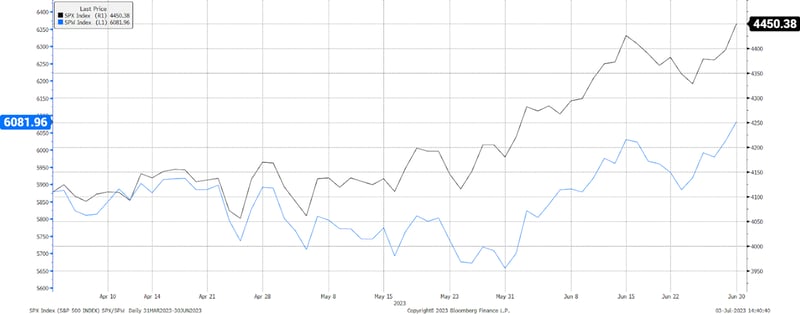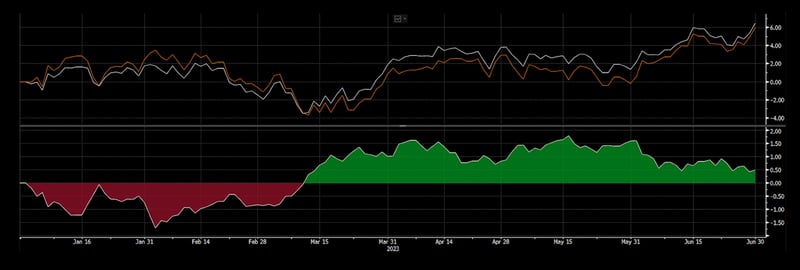Despite a challenging backdrop for dividend investing in 1H23, the Hilton Dividend and Yield Strategy (DIVYS) performed well. The strategy’s focus on risk adjusted returns resulted in solid performance during a quarter that experienced a significant rise in rates, led by the 2yr +87bp.
Market Commentary
First half of 2023 is done and dusted; what a six months it has been. Most investors came into 2023 positioned for higher volatility, wider credit spreads and economic headwinds. With many expecting an earnings and economic recession by Q223. Clearly, that is not how things have played out. While we will probably see four straight quarters of negative earnings growth, this has not been enough to offset a strong consumer and easing financial conditions. Solid progress has been made on inflation and, while economic growth continues to decline, the rate of change of that decline is much less than anticipated. Not even a hawkish Fed or tightening banking environment has been able to derail the risk on rallies in the markets. The S&P 500 had its best first half since 2019 while the Nasdaq 100 posted its best first half ever!
In short, the first half of 2023 has illustrated why we are not in a typical economic cycle. Excessive stimulus measures on the back of the pandemic created record savings for the US consumer. And it has taken longer than expected for the savings to be spent. As a result, the sensitivity of rising interest rates to the economic data has decreased significantly, which has resulted in a more resilient economy driven by consumer spending. This has kept the soft-landing scenario alive and has catalyzed a surprising rally in the equity and fixed income markets.
Figure 1: Easing Financial Conditions have been a catalyst to the markets

Source: Bloomberg
As the 2nd quarter began, the equity markets fed off the momentum created in Q1 and markets were led higher by the same sectors. Investors gained confidence as the US Government and Federal Reserve stepped in to support the banking system. This resulted in easing financial conditions which investors interpreted as a green light for risk assets. Better than expected Q1 earnings results, declining inflation data, constructive growth data and a surge in AI euphoria, gave investors hope that a soft landing could be achieved. We saw a broad risk on rally across all asset classes: VIX -27%, S&P 500 +8.3%, Nasdaq +12.8% and High Yield credit spreads 65bp tighter. Not even a significant increase in the yield curve could derail the rally--2yr rate +87bp or 21.6%. Large cap technology was clearly the big winner as they rode the cyclical/growth bid to new highs. Investors rotated out of cash and defensive sectors and into growth sectors as “FOMO” fears kicked in. As a result, the three “growthy” sectors (Technology, Consumer Discretionary, Communication Services) were the best performing sectors and outperformed the overall index returns.
Figure 2: Q2 Sector Performance for S&P 500

Source: Bloomberg
As the chart above illustrates, not all sectors benefited from the risk on rally in Q2. The breadth of the rally was very narrow and skewed to the Magnificent 7, which makes up roughly 28% of the cap weighted S&P 500. As Figure 3 illustrates, the S&P 500 outperformed the S&P 500 Equal weight by 4.8% in Q2 and 9.9% YTD. Over the last three months, 68% of stocks within the S&P 500 are underperforming the index—a clear indication of narrow breadth in the market rally.
Figure 3: S&P 500 vs S&P Equal Weight for Q223

Source: Bloomberg
The Q2 rally was not loved by all. The narrow nature of the rally and bearish positioning coming into the quarter left many investors behind. The quarter ended with a challenging technical backdrop as most markets are in overbought territory. Significant multiple expansion has the S&P trading at 19.3x and the Nasdaq at 31.5x, both above 10yr averages and multiples have expanded for three straight quarters. The equity and credit markets seem priced for perfection, which might be an issue as the tail risks continue to grow. Whether it be inflation, economic growth, fed policy, earnings or geopolitical turmoil, the markets are far from an “all clear” signal. But the unexpected rally during first half of 2023 does remind investors of the importance of remaining invested throughout an entire economic cycle.
Dividend and Yield Strategy Q223 Review
The Hilton Dividend and Yield Strategy made some tactical allocation shifts during Q223 which enabled the strategy to participate in the equity rallies and keep pace with the benchmark* on YTD returns. The strategy came into the quarter maintaining a defensive bias based on a slowing economic growth macro view. However, reacceleration of certain economic data and easing financial conditions increased the chance of a “soft landing” and warranted a change in the allocation of risk. The DIVYS portfolio shifted to a more neutral stance by reducing underweights in growth sectors and overweights in defensive sectors. The biggest shifts were an increase of 2% to both Information Technology and Communication Services sectors. This increase in allocation reflects a positive view on AI as the fundamental driver of spend across high end data infrastructure and fundamental bottoming in the semi market occurring in 2H23. In addition, Consumer Staples weighting was decreased by 3% as the effect of inflation on staples profits has been an excellent story but after seeing volume declines, we believe this catalyst is ending. The tactical nature of the DIVYS strategy continues to be a valuable asset as we move throughout the economic cycle.
Figure 4: Q2 Portfolio Sector Weightings vs S&P 500

For Q223, DIVYS underperformed its benchmark* by 62bp gross and 75bp net. As figure 5 illustrates, the strategy kept pace with the benchmark until the last month of the of the quarter, when an underweight position in Broadcom created a slight lag in performance.
Figure 5: Absolute Performance (top panel) & Relative Performance (bottom panel) for Q223

Source: Bloomberg
Quick rundown of Q2 Attribution:
- Average allocation to cash decreased to 3.4% (4.8% in Q123) as cash was deployed into various new positions.
- Yield on the portfolio as of 06/30/2023 was 2.03% and the beta was .88.
- The Dividend and Yields Strategy returned 4.44% gross /4.31% net, which was -62bp and -75bp behind the benchmark* return of 5.06%.
- Relative to the Nasdaq US Broad Dividend Achievers (DAATR), DIVYS was overweight communication services, healthcare, technology, and underweight financials, staples and industrials.
- Relative to the DAATR, overweighting healthcare (+2.09%) resulted in 71bps of outperformance, the best relative sector allocation. Healthcare contribution to relative return was driven by allocation and selection. AmerisourceBergen and Zimmer were the two best performing stocks in the sector.
- Relative to the DAATR, technology was the largest drag on return relative; primarily driven by selection. Underweight allocation to Broadcom and Oracle resulted in 96bp of underperformance.
- Top single-name contributors included XLC, ABC, RSG, ZBH and AMAT.
- Top single-name detractors included AVGO, ORCL and MA.
- Relative to the S&P500, DIVYS remained defensive, overweight staples, healthcare, utilities, and industrials. DIVYS remains underweight technology, financials, consumer discretionary, and communication services. But as stated earlier, the over and underweights were reduced to provide a more balanced risk profile in the portfolio.
- During the quarter we started new positions in LVMUY, TJX, CFR, BDX, NVO, CARR, AVGO, NVDA and ORCL. We exited positions in PPRUY, CL, TGT, ELV, PRGO, ADI, JNPR, ATR and IYZ.
| Top Contributors to Return | ||
| COMM SERVE SELECT SECTOR SPDR | 3.62 | 0.46 |
| AMERSOURCEBERGEN CORP | 1.82 | 0.32 |
| REPUBLIC SERVICES INC | 2.29 | 0.27 |
| ZIMMER BIOMENT HOLDINGS INC | 1.59 | 0.20 |
| Bottom Contributors to Return | Weight | CTR |
| BROADCOM INC | 0.32 | -0.56 |
| ORACLE CORP | 0.33 | -0.40 |
| MASTERCARD INC - A | 0.00 | -0.18 |
Quick rundown of First Half 2023 Attribution:
- The Hilton Dividend and Yield Strategy 1H23 return was +6.31% gross / +6.06% net, which is +35bp and +10bp ahead of the benchmark return of +5.96%*.
- The 1H outperformance was primarily the result of tactical moves that shifted the portfolio to a more balanced sector allocations throughout Q223 which enabled the strategy to participate in the narrow equity rally.
- The DIVYS strategy continues to maintain a lower standard deviation vs benchmark*—one year standard deviation of 15.5% vs benchmark* of 18.4%.
Figure 6: Absolute Performance (top panel) & Relative Performance (bottom panel) for 1H23

Source: Bloomberg
*Benchmark = NASDAQ US Broad Dividend Achievers TR







